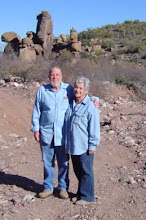12/29/07
We've wanted to go back to the old Boyer Cabin once the temperatures cooled off, the last time we were there was in the summertime and the snakes were still very active. Boyer Cabin is a pretty site, very rustic. The beautifully built corrals are still standing, along with the cabin, bunkhouse and barn, all shaded by a large grove of native Sycamore and Holly trees. It was once owned by Tom Boyer, one of the active participants in the Pleasant Valley Wars, 1882-1892, a murderous feud between sheepherders and cattlemen.
We took some time today to dig through the old dump behind the main cabin. Trash disposal must have been quite a problem back in pioneer days, so most trash was dumped outside the back door, often into a stream bed. Anyway, we didn't take a lot of time to dig, so there's still a lot to be checked out. We found the usual items, old cans, broken bottles, shoes, not much intact except an old glass doorknob. We also found a mule shoe behind the barn and Larry & Jean found a couple of horseshoes. Something else to add to our collective collections. We've noticed that people who live out in the desert as we do, often collect little "treasures" bringing them home as souvenirs of our explorations. Most of the things we find, we place in our cactus garden, to add an authentic rustic touch.

